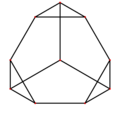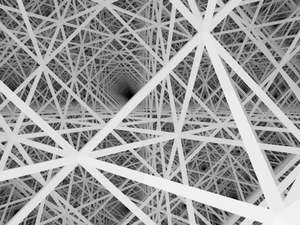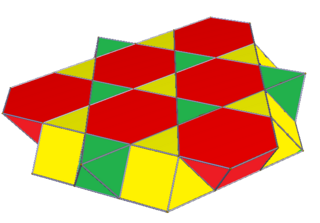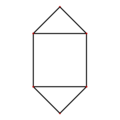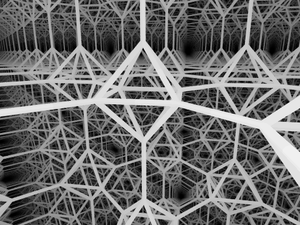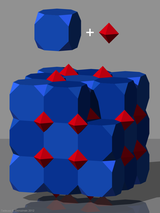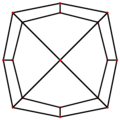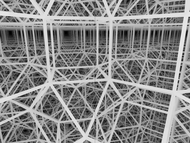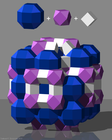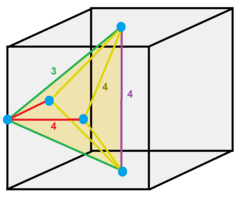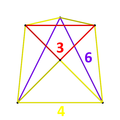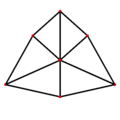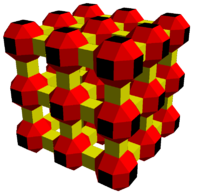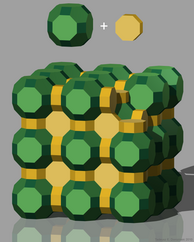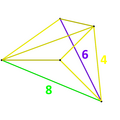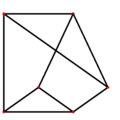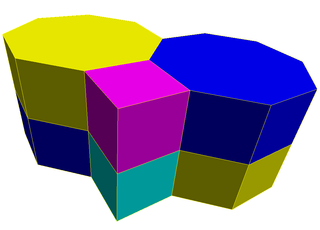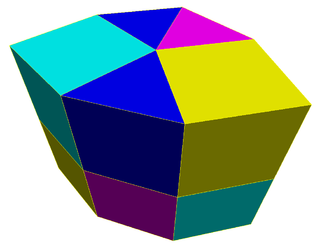| Cubic honeycomb | |
|---|---|
 
| |
| Type | Regular honeycomb |
| Family | Hypercube honeycomb |
| Inde xing[1] | J11,15,A1 W1,G22 |
| Schläfli symbol | {4,3,4} |
| Coxeter diagram | |
| Cell type | {4,3} |
| Face type | square{4} |
| Vertex figure |  octahedron |
| Space group Fibrifold notation |
Pm3m (221) 4−:2 |
| Coxeter group | ,[4,3,4] |
| Dual | self-dual Cell: 
|
| Properties | Vertex-transitive,regular |
Thecubic honeycomborcubic cellulationis the only proper regular space-fillingtessellation(orhoneycomb) inEuclidean 3-spacemade up ofcubiccells. It has 4 cubes around every edge, and 8 cubes around each vertex. Itsvertex figureis a regularoctahedron.It is aself-dualtessellation withSchläfli symbol{4,3,4}.John Horton Conwaycalled this honeycomb acubille.
Ageometric honeycombis aspace-fillingofpolyhedralor higher-dimensionalcells,so that there are no gaps. It is an example of the more general mathematicaltilingortessellationin any number of dimensions.
Honeycombs are usually constructed in ordinaryEuclidean( "flat" ) space, like theconvex uniform honeycombs.They may also be constructed innon-Euclidean spaces,such ashyperbolic uniform honeycombs.Any finiteuniform polytopecan be projected to itscircumsphereto form a uniform honeycomb in spherical space.
Related honeycombs
editIt is part of a multidimensional family ofhypercube honeycombs,withSchläfli symbolsof the form {4,3,...,3,4}, starting with thesquare tiling,{4,4} in the plane.
It is one of 28uniform honeycombsusingconvex uniform polyhedralcells.
Isometries of simple cubic lattices
editSimple cubic lattices can be distorted into lower symmetries, represented by lower crystal systems:
| Crystal system | Monoclinic Triclinic |
Orthorhombic | Tetragonal | Rhombohedral | Cubic |
|---|---|---|---|---|---|
| Unit cell | Parallelepiped | Rectangularcuboid | Squarecuboid | Trigonal trapezohedron |
Cube |
| Point group Order Rotation subgroup |
[ ], (*) Order 2 [ ]+,(1) |
[2,2], (*222) Order 8 [2,2]+,(222) |
[4,2], (*422) Order 16 [4,2]+,(422) |
[3], (*33) Order 6 [3]+,(33) |
[4,3], (*432) Order 48 [4,3]+,(432) |
| Diagram | 
|

|

|

|

|
| Space group Rotation subgroup |
Pm (6) P1 (1) |
Pmmm (47) P222 (16) |
P4/mmm (123) P422 (89) |
R3m (160) R3 (146) |
Pm3m (221) P432 (207) |
| Coxeter notation | - | [∞]a×[∞]b×[∞]c | [4,4]a×[∞]c | - | [4,3,4]a |
| Coxeter diagram | - | - |
Uniform colorings
editThere is a large number ofuniform colorings,derived from different symmetries. These include:
| Coxeter notation Space group |
Coxeter diagram | Schläfli symbol | Partial honeycomb |
Colors by letters |
|---|---|---|---|---|
| [4,3,4] Pm3m (221) |
{4,3,4} | 
|
1: aaaa/aaaa | |
| [4,31,1] = [4,3,4,1+] Fm3m (225) |
{4,31,1} | 2: abba/baab | ||
| [4,3,4] Pm3m (221) |
t0,3{4,3,4} | 
|
4: abbc/bccd | |
| [[4,3,4]] Pm3m (229) |
t0,3{4,3,4} | 4: abbb/bbba | ||
| [4,3,4,2,∞] | or |
{4,4}×t{∞} | 2: aaaa/bbbb | |
| [4,3,4,2,∞] | t1{4,4}×{∞} | 2: abba/abba | ||
| [∞,2,∞,2,∞] | t{∞}×t{∞}×{∞} | 4: abcd/abcd | ||
| [∞,2,∞,2,∞] = [4,(3,4)*] | t{∞}×t{∞}×t{∞} | 8: abcd/efgh |
Projections
editThecubic honeycombcan be orthogonally projected into the euclidean plane with various symmetry arrangements. The highest (hexagonal) symmetry form projects into atriangular tiling.A square symmetry projection forms asquare tiling.
| Symmetry | p6m (*632) | p4m (*442) | pmm (*2222) | ||
|---|---|---|---|---|---|
| Solid | 
|

|

| ||
| Frame | 
|

|

| ||
Related polytopes and honeycombs
editIt is related to the regular4-polytopetesseract,Schläfli symbol{4,3,3}, which exists in 4-space, and only has3cubes around each edge. It's also related to theorder-5 cubic honeycomb,Schläfli symbol {4,3,5}, ofhyperbolic spacewith 5 cubes around each edge.
It is in a sequence of polychora and honeycombs withoctahedralvertex figures.
| {p,3,4} regular honeycombs | |||||||||||
|---|---|---|---|---|---|---|---|---|---|---|---|
| Space | S3 | E3 | H3 | ||||||||
| Form | Finite | Affine | Compact | Paracompact | Noncompact | ||||||
| Name | {3,3,4} |
{4,3,4} |
{5,3,4} |
{6,3,4} |
{7,3,4} |
{8,3,4} |
...{∞,3,4} | ||||
| Image | 
|

|

|

|

|

|

| ||||
| Cells | {3,3} |
{4,3} |
{5,3} |
{6,3} |
{7,3} |
{8,3} |
{∞,3} | ||||
It in a sequence ofregular polytopesand honeycombs withcubiccells.
| {4,3,p} regular honeycombs | |||||||||||
|---|---|---|---|---|---|---|---|---|---|---|---|
| Space | S3 | E3 | H3 | ||||||||
| Form | Finite | Affine | Compact | Paracompact | Noncompact | ||||||
| Name |
{4,3,3} |
{4,3,4} |
{4,3,5} |
{4,3,6} |
{4,3,7} |
{4,3,8} |
...{4,3,∞} | ||||
| Image | 
|

|

|

|

|

|

| ||||
| Vertex figure |
 {3,3} |
 {3,4} |
 {3,5} |
 {3,6} |
 {3,7} |
 {3,8} |
 {3,∞} | ||||
| {p,3,p} regular honeycombs | |||||||||||
|---|---|---|---|---|---|---|---|---|---|---|---|
| Space | S3 | Euclidean E3 | H3 | ||||||||
| Form | Finite | Affine | Compact | Paracompact | Noncompact | ||||||
| Name | {3,3,3} | {4,3,4} | {5,3,5} | {6,3,6} | {7,3,7} | {8,3,8} | ...{∞,3,∞} | ||||
| Image | 
|

|

|

|

|

|

| ||||
| Cells |  {3,3} |
 {4,3} |
 {5,3} |
 {6,3} |
 {7,3} |
 {8,3} |
 {∞,3} | ||||
| Vertex figure |
 {3,3} |
 {3,4} |
 {3,5} |
 {3,6} |
 {3,7} |
 {3,8} |
 {3,∞} | ||||
Related polytopes
editThe cubic honeycomb has a lower symmetry as a runcinated cubic honeycomb, with two sizes ofcubes.A double symmetry construction can be constructed by placing a small cube into each large cube, resulting in a nonuniform honeycomb withcubes,square prisms, and rectangular trapezoprisms (a cube withD2dsymmetry). Its vertex figure is a triangular pyramid with its lateral faces augmented by tetrahedra.
The resulting honeycomb can be alternated to produce another nonuniform honeycomb with regulartetrahedra,two kinds of tetragonal disphenoids, triangular pyramids, and sphenoids. Its vertex figure hasC3vsymmetry and has 26 triangular faces, 39 edges, and 15 vertices.
Related Euclidean tessellations
editThe [4,3,4],![]()
![]()
![]()
![]()
![]()
![]()
![]() ,Coxeter groupgenerates 15 permutations of uniform tessellations, 9 with distinct geometry including the alternated cubic honeycomb. Theexpandedcubic honeycomb (also known as the runcinated cubic honeycomb) is geometrically identical to the cubic honeycomb.
,Coxeter groupgenerates 15 permutations of uniform tessellations, 9 with distinct geometry including the alternated cubic honeycomb. Theexpandedcubic honeycomb (also known as the runcinated cubic honeycomb) is geometrically identical to the cubic honeycomb.
| C3 honeycombs | |||||
|---|---|---|---|---|---|
| Space group |
Fibrifold | Extended symmetry |
Extended diagram |
Order | Honeycombs |
| Pm3m (221) |
4−:2 | [4,3,4] | ×1 | ||
| Fm3m (225) |
2−:2 | [1+,4,3,4] ↔ [4,31,1] |
↔ |
Half | |
| I43m (217) |
4o:2 | [[(4,3,4,2+)]] | Half × 2 | ||
| Fd3m (227) |
2+:2 | [[1+,4,3,4,1+]] ↔ [[3[4]]] |
↔ |
Quarter × 2 | |
| Im3m (229) |
8o:2 | [[4,3,4]] | ×2 | ||
The [4,31,1],![]()
![]()
![]()
![]()
![]() ,Coxeter groupgenerates 9 permutations of uniform tessellations, 4 with distinct geometry including the alternated cubic honeycomb.
,Coxeter groupgenerates 9 permutations of uniform tessellations, 4 with distinct geometry including the alternated cubic honeycomb.
| B3 honeycombs | |||||
|---|---|---|---|---|---|
| Space group |
Fibrifold | Extended symmetry |
Extended diagram |
Order | Honeycombs |
| Fm3m (225) |
2−:2 | [4,31,1] ↔ [4,3,4,1+] |
↔ |
×1 | |
| Fm3m (225) |
2−:2 | <[1+,4,31,1]> ↔ <[3[4]]> |
↔ |
×2 | |
| Pm3m (221) |
4−:2 | <[4,31,1]> | ×2 | ||
This honeycomb is one offive distinct uniform honeycombs[2]constructed by theCoxeter group.The symmetry can be multiplied by the symmetry of rings in theCoxeter–Dynkin diagrams:
| A3 honeycombs | ||||||
|---|---|---|---|---|---|---|
| Space group |
Fibrifold | Square symmetry |
Extended symmetry |
Extended diagram |
Extended group |
Honeycomb diagrams |
| F43m (216) |
1o:2 | a1 |
[3[4]] | (None) | ||
| Fm3m (225) |
2−:2 | d2 |
<[3[4]]> ↔ [4,31,1] |
↔ |
×21 ↔ |
|
| Fd3m (227) |
2+:2 | g2 |
[[3[4]]] or [2+[3[4]]] |
↔ |
×22 | |
| Pm3m (221) |
4−:2 | d4 |
<2[3[4]]> ↔ [4,3,4] |
↔ |
×41 ↔ |
|
| I3 (204) |
8−o | r8 |
[4[3[4]]]+ ↔ [[4,3+,4]] |
↔ |
½×8 ↔ ½×2 |
|
| Im3m (229) |
8o:2 | [4[3[4]]] ↔ [[4,3,4]] |
×8 ↔×2 |
|||
Rectified cubic honeycomb
edit| Rectified cubic honeycomb | |
|---|---|
| Type | Uniform honeycomb |
| Schläfli symbol | r{4,3,4} or t1{4,3,4} r{4,31,1} 2r{4,31,1} r{3[4]} |
| Coxeter diagrams | |
| Cells | r{4,3} {3,4} |
| Faces | triangle{3} square{4} |
| Vertex figure |  square prism |
| Space group Fibrifold notation |
Pm3m (221) 4−:2 |
| Coxeter group | ,[4,3,4] |
| Dual | oblate octahedrille Cell: 
|
| Properties | Vertex-transitive,edge-transitive |
Therectified cubic honeycomborrectified cubic cellulationis a uniform space-fillingtessellation(orhoneycomb) in Euclidean 3-space. It is composed ofoctahedraandcuboctahedrain a ratio of 1:1, with asquare prismvertex figure.
John Horton Conwaycalls this honeycomb acuboctahedrille,and its dual anoblate octahedrille.
Projections
editTherectified cubic honeycombcan be orthogonally projected into the euclidean plane with various symmetry arrangements.
| Symmetry | p6m (*632) | p4m (*442) | pmm (*2222) | ||
|---|---|---|---|---|---|
| Solid | 
|

|

| ||
| Frame | 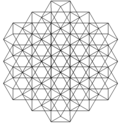
|
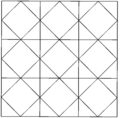
|

| ||
Symmetry
editThere are fouruniform coloringsfor the cells of this honeycomb with reflective symmetry, listed by theirCoxeter group,andWythoff constructionname, and theCoxeter diagrambelow.
| Symmetry | [4,3,4] |
[1+,4,3,4] [4,31,1], |
[4,3,4,1+] [4,31,1], |
[1+,4,3,4,1+] [3[4]], |
|---|---|---|---|---|
| Space group | Pm3m (221) |
Fm3m (225) |
Fm3m (225) |
F43m (216) |
| Coloring | 
|

|

|

|
| Coxeter diagram |
||||
| Vertex figure | 
|

|

|

|
| Vertex figure symmetry |
D4h [4,2] (*224) order 16 |
D2h [2,2] (*222) order 8 |
C4v [4] (*44) order 8 |
C2v [2] (*22) order 4 |
This honeycomb can be divided ontrihexagonal tilingplanes, using thehexagoncenters of the cuboctahedra, creating twotriangular cupolae.Thisscaliform honeycombis represented by Coxeter diagram![]()
![]()
![]()
![]()
![]()
![]()
![]() ,and symbol s3{2,6,3}, withcoxeter notationsymmetry [2+,6,3].
,and symbol s3{2,6,3}, withcoxeter notationsymmetry [2+,6,3].
Related polytopes
editA double symmetry construction can be made by placing octahedra on the cuboctahedra, resulting in a nonuniform honeycomb with two kinds ofoctahedra(regular octahedra and triangular antiprisms). The vertex figure is asquare bifrustum.The dual is composed ofelongated square bipyramids.
Truncated cubic honeycomb
edit| Truncated cubic honeycomb | |
|---|---|
| Type | Uniform honeycomb |
| Schläfli symbol | t{4,3,4} or t0,1{4,3,4} t{4,31,1} |
| Coxeter diagrams | |
| Cell type | t{4,3} {3,4} |
| Face type | triangle{3} octagon{8} |
| Vertex figure |  isoscelessquare pyramid |
| Space group Fibrifold notation |
Pm3m (221) 4−:2 |
| Coxeter group | ,[4,3,4] |
| Dual | Pyramidille Cell: 
|
| Properties | Vertex-transitive |
Thetruncated cubic honeycombortruncated cubic cellulationis a uniform space-fillingtessellation(orhoneycomb) in Euclidean 3-space. It is composed oftruncated cubesandoctahedrain a ratio of 1:1, with an isoscelessquare pyramidvertex figure.
John Horton Conwaycalls this honeycomb atruncated cubille,and its dualpyramidille.
Projections
editThetruncated cubic honeycombcan be orthogonally projected into the euclidean plane with various symmetry arrangements.
| Symmetry | p6m (*632) | p4m (*442) | pmm (*2222) | ||
|---|---|---|---|---|---|
| Solid | 
|

|
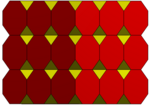
| ||
| Frame | 
|
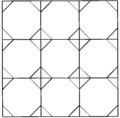
|
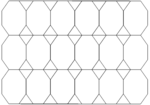
| ||
Symmetry
editThere is a seconduniform coloringby reflectional symmetry of theCoxeter groups,the second seen with alternately colored truncated cubic cells.
| Construction | Bicantellated alternate cubic | Truncated cubic honeycomb |
|---|---|---|
| Coxeter group | [4,31,1], | [4,3,4], =<[4,31,1]> |
| Space group | Fm3m | Pm3m |
| Coloring | 
|

|
| Coxeter diagram | ||
| Vertex figure | 
|

|
Related polytopes
editA double symmetry construction can be made by placing octahedra on the truncated cubes, resulting in a nonuniform honeycomb with two kinds ofoctahedra(regular octahedra and triangular antiprisms) and two kinds oftetrahedra(tetragonal disphenoids and digonal disphenoids). The vertex figure is an octakis square cupola.
Bitruncated cubic honeycomb
edit| Bitruncated cubic honeycomb | |
|---|---|
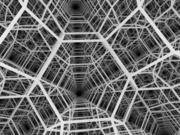 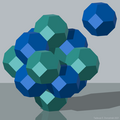
| |
| Type | Uniform honeycomb |
| Schläfli symbol | 2t{4,3,4} t1,2{4,3,4} |
| Coxeter-Dynkin diagram | |
| Cells | t{3,4} |
| Faces | square{4} hexagon{6} |
| Edge figure | isosceles triangle{3} |
| Vertex figure |  tetragonal disphenoid |
| Symmetry group Fibrifold notation Coxeter notation |
Im3m (229) 8o:2 [[4,3,4]] |
| Coxeter group | ,[4,3,4] |
| Dual | Oblate tetrahedrille Disphenoid tetrahedral honeycomb Cell: 
|
| Properties | Vertex-transitive,edge-transitive,cell-transitive |

Thebitruncated cubic honeycombis a space-fillingtessellation(orhoneycomb) inEuclidean 3-spacemade up oftruncated octahedra(or, equivalently,bitruncatedcubes). It has fourtruncated octahedraaround each vertex, in atetragonal disphenoidvertex figure.Being composed entirely oftruncated octahedra,it iscell-transitive.It is alsoedge-transitive,with 2 hexagons and one square on each edge, andvertex-transitive.It is one of 28uniform honeycombs.
John Horton Conwaycalls this honeycomb atruncated octahedrillein hisArchitectonic and catoptric tessellationlist, with its dual called anoblate tetrahedrille,also called adisphenoid tetrahedral honeycomb.Although a regulartetrahedroncan not tessellate space alone, this dual has identicaldisphenoid tetrahedroncells withisosceles trianglefaces.
Projections
editThebitruncated cubic honeycombcan be orthogonally projected into the euclidean plane with various symmetry arrangements. The highest (hexagonal) symmetry form projects into a nonuniformrhombitrihexagonal tiling.A square symmetry projection forms two overlappingtruncated square tiling,which combine together as achamfered square tiling.
| Symmetry | p6m (*632) | p4m (*442) | pmm (*2222) | ||
|---|---|---|---|---|---|
| Solid | 
|
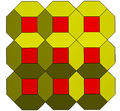
|

|
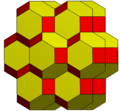
|
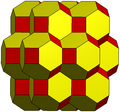
|
| Frame | 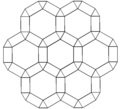
|

|

|
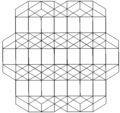
|
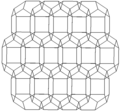
|
Symmetry
editThe vertex figure for this honeycomb is adisphenoid tetrahedron,and it is also theGoursat tetrahedron(fundamental domain) for theCoxeter group.This honeycomb has four uniform constructions, with the truncated octahedral cells having differentCoxeter groupsandWythoff constructions.These uniform symmetries can be represented by coloring differently the cells in each construction.
| Space group | Im3m (229) | Pm3m (221) | Fm3m (225) | F43m (216) | Fd3m (227) |
|---|---|---|---|---|---|
| Fibrifold | 8o:2 | 4−:2 | 2−:2 | 1o:2 | 2+:2 |
| Coxeter group | ×2 [[4,3,4]] =[4[3[4]]] |
[4,3,4] =[2[3[4]]] |
[4,31,1] =<[3[4]]> |
[3[4]] |
×2 [[3[4]]] =[[3[4]]] |
| Coxeter diagram | |||||
| truncated octahedra | 1 |
1:1 |
2:1:1 |
1:1:1:1 |
1:1 |
| Vertex figure | 
|

|

|

|

|
| Vertex figure symmetry |
[2+,4] (order 8) |
[2] (order 4) |
[ ] (order 2) |
[ ]+ (order 1) |
[2]+ (order 2) |
| Image Colored by cell |

|

|

|

|

|
Related polytopes
editNonuniform variants with [4,3,4] symmetry and two types of truncated octahedra can be doubled by placing the two types of truncated octahedra to produce a nonuniform honeycomb withtruncated octahedraandhexagonal prisms(as ditrigonal trapezoprisms). Its vertex figure is aC2v-symmetrictriangular bipyramid.
This honeycomb can then be alternated to produce another nonuniform honeycomb withpyritohedral icosahedra,octahedra(as triangular antiprisms), andtetrahedra(as sphenoids). Its vertex figure hasC2vsymmetry and consists of 2pentagons,4rectangles,4isosceles triangles(divided into two sets of 2), and 4scalene triangles.
Alternated bitruncated cubic honeycomb
edit| Alternated bitruncated cubic honeycomb | |
|---|---|
| Type | Convex honeycomb |
| Schläfli symbol | 2s{4,3,4} 2s{4,31,1} sr{3[4]} |
| Coxeter diagrams | |
| Cells | {3,3} s{3,3} |
| Faces | triangle{3} |
| Vertex figure | 
|
| Coxeter group | [[4,3+,4]], |
| Dual | Ten-of-diamonds honeycomb Cell: 
|
| Properties | Vertex-transitive,non-uniform |
Thealternated bitruncated cubic honeycomborbisnub cubic honeycombis non-uniform, with the highest symmetry construction reflecting an alternation of the uniform bitruncated cubic honeycomb. A lower-symmetry construction involves regular icosahedra paired with golden icosahedra (with 8 equilateral triangles paired with 12 golden triangles). There are three constructions from three relatedCoxeter diagrams:![]()
![]()
![]()
![]()
![]()
![]()
![]() ,
,![]()
![]()
![]()
![]()
![]() ,and
,and![]()
![]()
![]()
![]()
![]() .These have symmetry [4,3+,4], [4,(31,1)+] and [3[4]]+respectively. The first and last symmetry can be doubled as [[4,3+,4]] and [[3[4]]]+.
.These have symmetry [4,3+,4], [4,(31,1)+] and [3[4]]+respectively. The first and last symmetry can be doubled as [[4,3+,4]] and [[3[4]]]+.
This honeycomb is represented in the boron atoms of theα-rhombohedral crystal.The centers of the icosahedra are located at the fcc positions of the lattice.[3]
| Space group | I3(204) | Pm3(200) | Fm3(202) | Fd3(203) | F23 (196) |
|---|---|---|---|---|---|
| Fibrifold | 8−o | 4− | 2− | 2o+ | 1o |
| Coxeter group | [[4,3+,4]] | [4,3+,4] | [4,(31,1)+] | [[3[4]]]+ | [3[4]]+ |
| Coxeter diagram | |||||
| Order | double | full | half | quarter double |
quarter |
Cantellated cubic honeycomb
edit| Cantellated cubic honeycomb | |
|---|---|
| Type | Uniform honeycomb |
| Schläfli symbol | rr{4,3,4} or t0,2{4,3,4} rr{4,31,1} |
| Coxeter diagram | |
| Cells | rr{4,3} r{4,3} {}x{4} |
| Vertex figure |  wedge |
| Space group Fibrifold notation |
Pm3m (221) 4−:2 |
| Coxeter group | [4,3,4], |
| Dual | quarter oblate octahedrille Cell: 
|
| Properties | Vertex-transitive |
Thecantellated cubic honeycomborcantellated cubic cellulationis a uniform space-fillingtessellation(orhoneycomb) in Euclidean 3-space. It is composed ofrhombicuboctahedra,cuboctahedra,andcubesin a ratio of 1:1:3, with awedgevertex figure.
John Horton Conwaycalls this honeycomb a2-RCO-trille,and its dualquarter oblate octahedrille.
Images
edit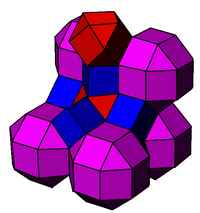
|
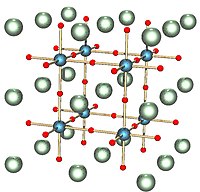 It is closely related to theperovskite structure,shown here with cubic symmetry, with atoms placed at the center of the cells of this honeycomb. |
Projections
editThecantellated cubic honeycombcan be orthogonally projected into the euclidean plane with various symmetry arrangements.
| Symmetry | p6m (*632) | p4m (*442) | pmm (*2222) | ||
|---|---|---|---|---|---|
| Solid | 
|
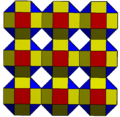
|
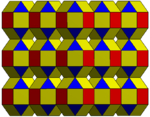
| ||
| Frame | 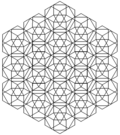
|
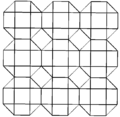
|
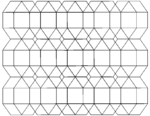
| ||
Symmetry
editThere is a seconduniform coloringsby reflectional symmetry of theCoxeter groups,the second seen with alternately colored rhombicuboctahedral cells.
| Construction | Truncated cubic honeycomb | Bicantellated alternate cubic |
|---|---|---|
| Coxeter group | [4,3,4], =<[4,31,1]> |
[4,31,1], |
| Space group | Pm3m | Fm3m |
| Coxeter diagram | ||
| Coloring | 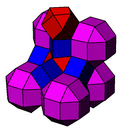
|
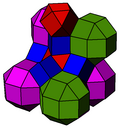
|
| Vertex figure | 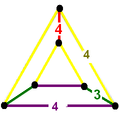
|
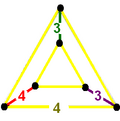
|
| Vertex figure symmetry |
[ ] order 2 |
[ ]+ order 1 |
Related polytopes
editA double symmetry construction can be made by placing cuboctahedra on the rhombicuboctahedra, which results in therectified cubic honeycomb,by taking the triangular antiprism gaps as regularoctahedra,square antiprism pairs and zero-height tetragonal disphenoids as components of thecuboctahedron.Other variants result incuboctahedra,square antiprisms,octahedra(as triangular antipodiums), andtetrahedra(as tetragonal disphenoids), with a vertex figure topologically equivalent to acubewith atriangular prismattached to one of its square faces.
Quarter oblate octahedrille
editThe dual of thecantellated cubic honeycombis called aquarter oblate octahedrille,acatoptric tessellationwithCoxeter diagram![]()
![]()
![]()
![]()
![]()
![]()
![]() ,containing faces from two of four hyperplanes of the cubic [4,3,4] fundamental domain.
,containing faces from two of four hyperplanes of the cubic [4,3,4] fundamental domain.
It has irregular triangle bipyramid cells which can be seen as 1/12 of a cube, made from the cube center, 2 face centers, and 2 vertices.
Cantitruncated cubic honeycomb
edit| Cantitruncated cubic honeycomb | |
|---|---|
| Type | Uniform honeycomb |
| Schläfli symbol | tr{4,3,4} or t0,1,2{4,3,4} tr{4,31,1} |
| Coxeter diagram | |
| Cells | tr{4,3} t{3,4} {}x{4} |
| Faces | square{4} hexagon{6} octagon{8} |
| Vertex figure |   mirrored sphenoid |
| Coxeter group | [4,3,4], |
| Symmetry group Fibrifold notation |
Pm3m (221) 4−:2 |
| Dual | triangular pyramidille Cells: 
|
| Properties | Vertex-transitive |
Thecantitruncated cubic honeycomborcantitruncated cubic cellulationis a uniform space-fillingtessellation(orhoneycomb) in Euclidean 3-space, made up oftruncated cuboctahedra,truncated octahedra,andcubesin a ratio of 1:1:3, with amirrored sphenoidvertex figure.
John Horton Conwaycalls this honeycomb an-tCO-trille,and its dualtriangular pyramidille.
Images
editFour cells exist around each vertex:
Projections
editThecantitruncated cubic honeycombcan be orthogonally projected into the euclidean plane with various symmetry arrangements.
| Symmetry | p6m (*632) | p4m (*442) | pmm (*2222) | ||
|---|---|---|---|---|---|
| Solid | 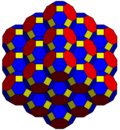
|
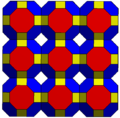
|

| ||
| Frame | 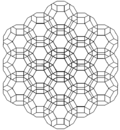
|
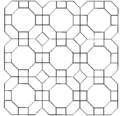
|
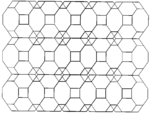
| ||
Symmetry
editCells can be shown in two different symmetries. The linearCoxeter diagramform can be drawn with one color for each cell type. The bifurcating diagram form can be drawn with two types (colors) oftruncated cuboctahedroncells alternating.
| Construction | Cantitruncated cubic | Omnitruncated alternate cubic |
|---|---|---|
| Coxeter group | [4,3,4], =<[4,31,1]> |
[4,31,1], |
| Space group | Pm3m (221) | Fm3m (225) |
| Fibrifold | 4−:2 | 2−:2 |
| Coloring | 
|

|
| Coxeter diagram | ||
| Vertex figure | 
|

|
| Vertex figure symmetry |
[ ] order 2 |
[ ]+ order 1 |
Triangular pyramidille
editThe dual of thecantitruncated cubic honeycombis called atriangular pyramidille,withCoxeter diagram,![]()
![]()
![]()
![]()
![]()
![]()
![]() .This honeycomb cells represents the fundamental domains ofsymmetry.
.This honeycomb cells represents the fundamental domains ofsymmetry.
A cell can be as 1/24 of a translational cube with vertices positioned: taking two corner, ne face center, and the cube center. The edge colors and labels specify how many cells exist around the edge.
Related polyhedra and honeycombs
editIt is related to askew apeirohedronwithvertex configuration4.4.6.6, with the octagons and some of the squares removed. It can be seen as constructed by augmenting truncated cuboctahedral cells, or by augmenting alternated truncated octahedra and cubes.

|

|
Related polytopes
editA double symmetry construction can be made by placing truncated octahedra on the truncated cuboctahedra, resulting in a nonuniform honeycomb withtruncated octahedra,hexagonal prisms(as ditrigonal trapezoprisms),cubes(as square prisms),triangular prisms(asC2v-symmetric wedges), andtetrahedra(as tetragonal disphenoids). Its vertex figure is topologically equivalent to theoctahedron.
Alternated cantitruncated cubic honeycomb
edit| Alternated cantitruncated cubic honeycomb | |
|---|---|
| Type | Convex honeycomb |
| Schläfli symbol | sr{4,3,4} sr{4,31,1} |
| Coxeter diagrams | |
| Cells | s{4,3} s{3,3} {3,3} |
| Faces | triangle{3} square{4} |
| Vertex figure |  
|
| Coxeter group | [(4,3)+,4] |
| Dual | Cell: 
|
| Properties | Vertex-transitive,non-uniform |
Thealternated cantitruncated cubic honeycomborsnub rectified cubic honeycombcontains three types of cells:snub cubes,icosahedra(withThsymmetry),tetrahedra(as tetragonal disphenoids), and new tetrahedral cells created at the gaps.
Although it is not uniform, constructionally it can be given asCoxeter diagrams![]()
![]()
![]()
![]()
![]() or
or![]()
![]()
![]()
![]()
![]()
![]()
![]() .
.
Despite being non-uniform, there is a near-miss version with two edge lengths shown below, one of which is around 4.3% greater than the other. The snub cubes in this case are uniform, but the rest of the cells are not.
 |
 |
Cantic snub cubic honeycomb
edit| Orthosnub cubic honeycomb | |
|---|---|
| Type | Convex honeycomb |
| Schläfli symbol | 2s0{4,3,4} |
| Coxeter diagrams | |
| Cells | s2{3,4} s{3,3} {}x{3} |
| Faces | triangle{3} square{4} |
| Vertex figure | 
|
| Coxeter group | [4+,3,4] |
| Dual | Cell:
|
| Properties | Vertex-transitive,non-uniform |
Thecantic snub cubic honeycombis constructed by snubbing thetruncated octahedrain a way that leaves onlyrectanglesfrom thecubes(square prisms). It is not uniform but it can be represented asCoxeter diagram![]()
![]()
![]()
![]()
![]()
![]()
![]() .It hasrhombicuboctahedra(withThsymmetry),icosahedra(withThsymmetry), andtriangular prisms(asC2v-symmetry wedges) filling the gaps.[4]
.It hasrhombicuboctahedra(withThsymmetry),icosahedra(withThsymmetry), andtriangular prisms(asC2v-symmetry wedges) filling the gaps.[4]
Related polytopes
editA double symmetry construction can be made by placing icosahedra on the rhombicuboctahedra, resulting in a nonuniform honeycomb withicosahedra,octahedra(as triangular antiprisms),triangular prisms(asC2v-symmetric wedges), andsquare pyramids.
Runcitruncated cubic honeycomb
edit| Runcitruncated cubic honeycomb | |
|---|---|
| Type | Uniform honeycomb |
| Schläfli symbol | t0,1,3{4,3,4} |
| Coxeter diagrams | |
| Cells | rr{4,3} t{4,3} {}x{8} {}x{4} |
| Faces | triangle{3} square{4} octagon{8} |
| Vertex figure |  isosceles-trapezoidalpyramid |
| Coxeter group | [4,3,4], |
| Space group Fibrifold notation |
Pm3m (221) 4−:2 |
| Dual | square quarter pyramidille Cell 
|
| Properties | Vertex-transitive |
Theruncitruncated cubic honeycomborruncitruncated cubic cellulationis a uniformspace-filling tessellation(orhoneycomb) in Euclidean 3-space. It is composed ofrhombicuboctahedra,truncated cubes,octagonal prisms,andcubesin a ratio of 1:1:3:3, with anisosceles-trapezoidalpyramidvertex figure.
Its name is derived from itsCoxeter diagram,![]()
![]()
![]()
![]()
![]()
![]()
![]() with three ringed nodes representing 3 active mirrors in theWythoff constructionfrom its relation to theregularcubic honeycomb.
with three ringed nodes representing 3 active mirrors in theWythoff constructionfrom its relation to theregularcubic honeycomb.
John Horton Conwaycalls this honeycomb a1-RCO-trille,and its dualsquare quarter pyramidille.

|

|
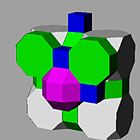
|

|
Projections
editTheruncitruncated cubic honeycombcan be orthogonally projected into the euclidean plane with various symmetry arrangements.
| Symmetry | p6m (*632) | p4m (*442) | pmm (*2222) | ||
|---|---|---|---|---|---|
| Solid | 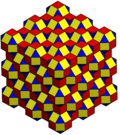
|

|
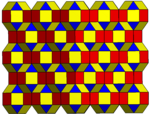
| ||
| Frame | 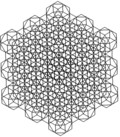
|

|
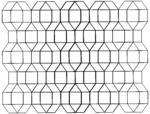
| ||
Related skew apeirohedron
editTwo related uniformskew apeirohedronsexists with the samevertex arrangement,seen as boundary cells from a subset of cells. One has triangles and squares, and the other triangles, squares, and octagons.
Square quarter pyramidille
editThe dual to theruncitruncated cubic honeycombis called asquare quarter pyramidille,withCoxeter diagram![]()
![]()
![]()
![]()
![]()
![]()
![]() .Faces exist in 3 of 4 hyperplanes of the [4,3,4],Coxeter group.
.Faces exist in 3 of 4 hyperplanes of the [4,3,4],Coxeter group.
Cells are irregular pyramids and can be seen as 1/24 of a cube, using one corner, one mid-edge point, two face centers, and the cube center.
Related polytopes
editA double symmetry construction can be made by placing rhombicuboctahedra on the truncated cubes, resulting in a nonuniform honeycomb withrhombicuboctahedra,octahedra(as triangular antiprisms),cubes(as square prisms), two kinds oftriangular prisms(bothC2v-symmetric wedges), andtetrahedra(as digonal disphenoids). Its vertex figure is topologically equivalent to theaugmented triangular prism.
Omnitruncated cubic honeycomb
edit| Omnitruncated cubic honeycomb | |
|---|---|
| Type | Uniform honeycomb |
| Schläfli symbol | t0,1,2,3{4,3,4} |
| Coxeter diagram | |
| Cells | tr{4,3} {}x{8} |
| Faces | square{4} hexagon{6} octagon{8} |
| Vertex figure |  phyllic disphenoid |
| Symmetry group Fibrifold notation Coxeter notation |
Im3m (229) 8o:2 [[4,3,4]] |
| Coxeter group | [4,3,4], |
| Dual | eighth pyramidille Cell 
|
| Properties | Vertex-transitive |
Theomnitruncated cubic honeycomboromnitruncated cubic cellulationis a uniform space-fillingtessellation(orhoneycomb) in Euclidean 3-space. It is composed oftruncated cuboctahedraandoctagonal prismsin a ratio of 1:3, with aphyllic disphenoidvertex figure.
John Horton Conwaycalls this honeycomb ab-tCO-trille,and its dualeighth pyramidille.
Projections
editTheomnitruncated cubic honeycombcan be orthogonally projected into the euclidean plane with various symmetry arrangements.
| Symmetry | p6m (*632) | p4m (*442) | pmm (*2222) | ||
|---|---|---|---|---|---|
| Solid | 
|

|
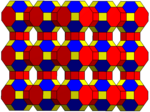
| ||
| Frame | 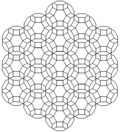
|
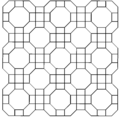
|

| ||
Symmetry
editCells can be shown in two different symmetries. TheCoxeter diagramform has two colors oftruncated cuboctahedraandoctagonal prisms.The symmetry can be doubled by relating the first and last branches of the Coxeter diagram, which can be shown with one color for all the truncated cuboctahedral and octagonal prism cells.
| Symmetry | ,[4,3,4] | ×2, [[4,3,4]] |
|---|---|---|
| Space group | Pm3m (221) | Im3m (229) |
| Fibrifold | 4−:2 | 8o:2 |
| Coloring | 
|

|
| Coxeter diagram | ||
| Vertex figure | 
|

|
Related polyhedra
editTwo related uniformskew apeirohedronexist with the samevertex arrangement.The first has octagons removed, and vertex configuration 4.4.4.6. It can be seen as truncated cuboctahedra and octagonal prisms augmented together. The second can be seen as augmented octagonal prisms, vertex configuration 4.8.4.8.
4.4.4.6
|
4.8.4.8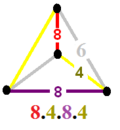
|
|---|---|

|

|
Related polytopes
editNonuniform variants with [4,3,4] symmetry and two types of truncated cuboctahedra can be doubled by placing the two types of truncated cuboctahedra on each other to produce a nonuniform honeycomb withtruncated cuboctahedra,octagonal prisms,hexagonal prisms(as ditrigonal trapezoprisms), and two kinds ofcubes(as rectangular trapezoprisms and theirC2v-symmetric variants). Its vertex figure is an irregulartriangular bipyramid.
This honeycomb can then be alternated to produce another nonuniform honeycomb withsnub cubes,square antiprisms,octahedra(as triangular antiprisms), and three kinds oftetrahedra(as tetragonal disphenoids, phyllic disphenoids, and irregular tetrahedra).
Alternated omnitruncated cubic honeycomb
edit| Alternated omnitruncated cubic honeycomb | |
|---|---|
| Type | Convex honeycomb |
| Schläfli symbol | ht0,1,2,3{4,3,4} |
| Coxeter diagram | |
| Cells | s{4,3} s{2,4} {3,3} |
| Faces | triangle{3} square{4} |
| Vertex figure |  
|
| Symmetry | [[4,3,4]]+ |
| Dual | Dual alternated omnitruncated cubic honeycomb |
| Properties | Vertex-transitive,non-uniform |
Analternated omnitruncated cubic honeycomboromnisnub cubic honeycombcan be constructed byalternationof the omnitruncated cubic honeycomb, although it can not be made uniform, but it can be givenCoxeter diagram:![]()
![]()
![]()
![]()
![]()
![]()
![]() and has symmetry [[4,3,4]]+.It makessnub cubesfrom thetruncated cuboctahedra,square antiprismsfrom theoctagonal prisms,and creates newtetrahedralcells from the gaps.
and has symmetry [[4,3,4]]+.It makessnub cubesfrom thetruncated cuboctahedra,square antiprismsfrom theoctagonal prisms,and creates newtetrahedralcells from the gaps.
Dual alternated omnitruncated cubic honeycomb
edit| Dual alternated omnitruncated cubic honeycomb | |
|---|---|
| Type | Dual alternated uniform honeycomb |
| Schläfli symbol | dht0,1,2,3{4,3,4} |
| Coxeter diagram | |
| Cell | 
|
| Vertex figures | pentagonal icositetrahedron tetragonal trapezohedron tetrahedron |
| Symmetry | [[4,3,4]]+ |
| Dual | Alternated omnitruncated cubic honeycomb |
| Properties | Cell-transitive |
Adual alternated omnitruncated cubic honeycombis a space-filling honeycomb constructed as the dual of thealternated omnitruncated cubic honeycomb.
24 cells fit around a vertex, making a chiraloctahedral symmetrythat can be stacked in all 3-dimensions:
Individual cells have 2-fold rotational symmetry. In 2D orthogonal projection, this looks like a mirror symmetry.
 Net |
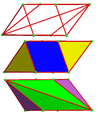
|

| |

|
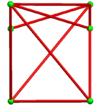
|

|

|
Runcic cantitruncated cubic honeycomb
edit| Runcic cantitruncated cubic honeycomb | |
|---|---|
| Type | Convex honeycomb |
| Schläfli symbol | sr3{4,3,4} |
| Coxeter diagrams | |
| Cells | s2{3,4} s{4,3} {}x{4} {}x{3} |
| Faces | triangle{3} square{4} |
| Vertex figure | 
|
| Coxeter group | [4,3+,4] |
| Dual | Cell:
|
| Properties | Vertex-transitive,non-uniform |
Theruncic cantitruncated cubic honeycomborruncic cantitruncated cubic cellulationis constructed by removing alternating long rectangles from the octagons and is not uniform, but it can be represented asCoxeter diagram![]()
![]()
![]()
![]()
![]()
![]()
![]() .It hasrhombicuboctahedra(withThsymmetry),snub cubes,two kinds ofcubes:square prisms and rectangular trapezoprisms (topologically equivalent to acubebut withD2dsymmetry), andtriangular prisms(asC2v-symmetry wedges) filling the gaps.
.It hasrhombicuboctahedra(withThsymmetry),snub cubes,two kinds ofcubes:square prisms and rectangular trapezoprisms (topologically equivalent to acubebut withD2dsymmetry), andtriangular prisms(asC2v-symmetry wedges) filling the gaps.
Biorthosnub cubic honeycomb
edit| Biorthosnub cubic honeycomb | |
|---|---|
| Type | Convex honeycomb |
| Schläfli symbol | 2s0,3{4,3,4} |
| Coxeter diagrams | |
| Cells | s2{3,4} {}x{4} |
| Faces | triangle{3} square{4} |
| Vertex figure |  (Tetragonal antiwedge) |
| Coxeter group | [[4,3+,4]] |
| Dual | Cell:
|
| Properties | Vertex-transitive,non-uniform |
Thebiorthosnub cubic honeycombis constructed by removing alternating long rectangles from the octagons orthogonally and is not uniform, but it can be represented asCoxeter diagram![]()
![]()
![]()
![]()
![]()
![]()
![]() .It hasrhombicuboctahedra(withThsymmetry) and two kinds ofcubes:square prisms and rectangular trapezoprisms (topologically equivalent to acubebut withD2dsymmetry).
.It hasrhombicuboctahedra(withThsymmetry) and two kinds ofcubes:square prisms and rectangular trapezoprisms (topologically equivalent to acubebut withD2dsymmetry).
Truncated square prismatic honeycomb
edit| Truncated square prismatic honeycomb | |
|---|---|
| Type | Uniform honeycomb |
| Schläfli symbol | t{4,4}×{∞} or t0,1,3{4,4,2,∞} tr{4,4}×{∞} or t0,1,2,3{4,4,∞} |
| Coxeter-Dynkin diagram | |
| Cells | {}x{8} {}x{4} |
| Faces | square{4} octagon{8} |
| Coxeter group | [4,4,2,∞] |
| Dual | Tetrakis square prismatic tiling Cell: 
|
| Properties | Vertex-transitive |
Thetruncated square prismatic honeycombortomo-square prismatic cellulationis a space-fillingtessellation(orhoneycomb) inEuclidean 3-space.It is composed ofoctagonal prismsandcubesin a ratio of 1:1.
It is constructed from atruncated square tilingextruded into prisms.
It is one of 28convex uniform honeycombs.
Snub square prismatic honeycomb
edit| Snub square prismatic honeycomb | |
|---|---|
| Type | Uniform honeycomb |
| Schläfli symbol | s{4,4}×{∞} sr{4,4}×{∞} |
| Coxeter-Dynkin diagram | |
| Cells | {}x{4} {}x{3} |
| Faces | triangle{3} square{4} |
| Coxeter group | [4+,4,2,∞] [(4,4)+,2,∞] |
| Dual | Cairo pentagonal prismatic honeycomb Cell: 
|
| Properties | Vertex-transitive |
Thesnub square prismatic honeycomborsimo-square prismatic cellulationis a space-fillingtessellation(orhoneycomb) inEuclidean 3-space.It is composed ofcubesandtriangular prismsin a ratio of 1:2.
It is constructed from asnub square tilingextruded into prisms.
It is one of 28convex uniform honeycombs.
Snub square antiprismatic honeycomb
edit| Snub square antiprismatic honeycomb | |
|---|---|
| Type | Convex honeycomb |
| Schläfli symbol | ht1,2,3{4,4,2,∞} ht0,1,2,3{4,4,∞} |
| Coxeter-Dynkin diagram | |
| Cells | s{2,4} {3,3} |
| Faces | triangle{3} square{4} |
| Vertex figure | 
|
| Symmetry | [4,4,2,∞]+ |
| Properties | Vertex-transitive,non-uniform |
Asnub square antiprismatic honeycombcan be constructed byalternationof the truncated square prismatic honeycomb, although it can not be made uniform, but it can be givenCoxeter diagram:![]()
![]()
![]()
![]()
![]()
![]()
![]()
![]()
![]() and has symmetry [4,4,2,∞]+.It makessquare antiprismsfrom theoctagonal prisms,tetrahedra(as tetragonal disphenoids) from thecubes,and two tetrahedra from thetriangular bipyramids.
and has symmetry [4,4,2,∞]+.It makessquare antiprismsfrom theoctagonal prisms,tetrahedra(as tetragonal disphenoids) from thecubes,and two tetrahedra from thetriangular bipyramids.
See also
edit- Architectonic and catoptric tessellation
- Alternated cubic honeycomb
- List of regular polytopes
- Order-5 cubic honeycombA hyperbolic cubic honeycomb with 5 cubes per edge
- Snub (geometry)
- Voxel
References
edit- John H. Conway,Heidi Burgiel,Chaim Goodman-Strauss,(2008)The Symmetries of Things,ISBN978-1-56881-220-5(Chapter 21, Naming the Archimedean and Catalan polyhedra and tilings, Architectonic and Catoptric tessellations, p 292-298, includes all the nonprismatic forms)
- Coxeter, H.S.M.Regular Polytopes,(3rd edition, 1973), Dover edition,ISBN0-486-61480-8p. 296, Table II: Regular honeycombs
- George Olshevsky,Uniform Panoploid Tetracombs,Manuscript (2006)(Complete list of 11 convex uniform tilings, 28 convex uniform honeycombs, and 143 convex uniform tetracombs)
- Branko Grünbaum,Uniform tilings of 3-space.Geombinatorics4(1994), 49 - 56.
- Kaleidoscopes: Selected Writings of H.S.M. Coxeter,edited by F. Arthur Sherk, Peter McMullen, Anthony C. Thompson, Asia Ivic Weiss, Wiley-Interscience Publication, 1995,ISBN978-0-471-01003-6[2]
- (Paper 22) H.S.M. Coxeter,Regular and Semi Regular Polytopes I,[Math. Zeit. 46 (1940) 380-407, MR 2,10] (1.9 Uniform space-fillings)
- A. Andreini,Sulle reti di poliedri regolari e semiregolari e sulle corrispondenti reti correlative(On the regular and semiregular nets of polyhedra and on the corresponding correlative nets), Mem. Società Italiana della Scienze, Ser.3, 14 (1905) 75–129.
- Klitzing, Richard."3D Euclidean Honeycombs x4o3o4o - chon - O1".
- Uniform Honeycombs in 3-Space: 01-Chon
| Space | Family | // | ||||
|---|---|---|---|---|---|---|
| E2 | Uniform tiling | 0[3] | δ3 | hδ3 | qδ3 | Hexagonal |
| E3 | Uniform convex honeycomb | 0[4] | δ4 | hδ4 | qδ4 | |
| E4 | Uniform 4-honeycomb | 0[5] | δ5 | hδ5 | qδ5 | 24-cell honeycomb |
| E5 | Uniform 5-honeycomb | 0[6] | δ6 | hδ6 | qδ6 | |
| E6 | Uniform 6-honeycomb | 0[7] | δ7 | hδ7 | qδ7 | 222 |
| E7 | Uniform 7-honeycomb | 0[8] | δ8 | hδ8 | qδ8 | 133•331 |
| E8 | Uniform 8-honeycomb | 0[9] | δ9 | hδ9 | qδ9 | 152•251•521 |
| E9 | Uniform 9-honeycomb | 0[10] | δ10 | hδ10 | qδ10 | |
| E10 | Uniform 10-honeycomb | 0[11] | δ11 | hδ11 | qδ11 | |
| En-1 | Uniform (n-1)-honeycomb | 0[n] | δn | hδn | qδn | 1k2•2k1•k21 |

